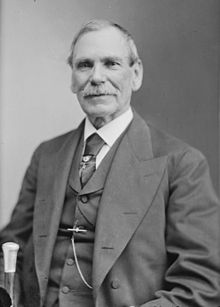James Shields | |
|---|---|
 | |
| United States Senator from Missouri | |
| In office January 27, 1879 – March 3, 1879 | |
| Preceded by | David H. Armstrong |
| Succeeded by | George Graham Vest |
| United States Senator from Minnesota | |
| In office May 11, 1858 – March 3, 1859 | |
| Preceded by | Himself (Shadow Senator) |
| Succeeded by | Morton S. Wilkinson |
| United States Shadow Senator from the Minnesota Territory | |
| In office December 19, 1857 – May 11, 1858 | |
| Preceded by | Seat established |
| Succeeded by | Himself (U.S. Senator) |
| United States Senator from Illinois | |
| In office October 27, 1849 – March 3, 1855 | |
| Preceded by | Himself |
| Succeeded by | Lyman Trumbull |
| In office March 4, 1849 – March 15, 1849[a] | |
| Preceded by | Sidney Breese |
| Succeeded by | Himself |
| Commissioner of the General Land Office | |
| In office April 16, 1845 – January 5, 1847 | |
| President | James K. Polk |
| Preceded by | Thomas H. Blake |
| Succeeded by | Richard M. Young |
| Auditor of Illinois | |
| In office 1841–1843 | |
| Governor | Thomas Carlin Thomas Ford |
| Preceded by | Levi Davis |
| Succeeded by | William Lee D. Ewing |
| Personal details | |
| Born | May 10, 1806 Altmore, Ireland, United Kingdom |
| Died | June 1, 1879 (aged 73) Ottumwa, Iowa, U.S. |
| Political party | Democratic |
| Education | University of Glasgow (BA) |
| Signature | |
| Military service | |
| Allegiance | United States |
| Branch/service | United States Army Union Army |
| Years of service | 1832 1835–1842 1846–1848 1861–1862 |
| Rank | |
| Battles/wars | Second Seminole War Mexican–American War American Civil War |
James Shields (May 10, 1806[b] – June 1, 1879) was an Irish American politician and United States Army officer, who is the only person in U.S. history to serve as a Senator for three different states, and one of only two to represent multiple states in the U.S. Senate. A member of the Democratic Party, Shields represented Illinois from 1849 to 1855, in the 31st, 32nd, and 33rd Congresses, Minnesota from 1858 to 1859, in the 35th Congress, and Missouri in 1879, in the 45th Congress.
Born and initially educated in Ireland, Shields emigrated to the Americas in 1826. He was briefly a sailor, and spent time in Quebec, before settling in Kaskaskia, Illinois, where he studied and practiced law. In 1836, he was elected to the Illinois House of Representatives, and later as State Auditor. His work as auditor was criticized by a young Abraham Lincoln, who (with his then fiancée, Mary Todd) published a series of inflammatory pseudonymous letters in a local paper. Shields challenged Lincoln to a duel, and the two nearly fought on September 22, 1842, before making peace, and eventually becoming friends.
In 1845, Shields was appointed to the Illinois Supreme Court, from which he resigned to become Commissioner of the U.S. United States General Land Office. At the outbreak of the Mexican–American War, he left the Land Office to take an appointment as brigadier general of volunteers. He served with distinction and was twice wounded. In 1848, Shields was appointed to and confirmed by the Senate as the first governor of the Oregon Territory, which he declined. After serving as Senator from Illinois, he moved to Minnesota and founded the town of Shieldsville there. He was then elected as Senator from Minnesota. He served in the American Civil War, and at the Battle of Kernstown, his troops inflicted the only tactical defeat of Stonewall Jackson in the war. Shields resigned his commission shortly thereafter. After moving multiple times, Shields settled in Missouri and served again for three months in the Senate. He died in 1879 and represents Illinois in the National Statuary Hall.
Cite error: There are <ref group=lower-alpha> tags or {{efn}} templates on this page, but the references will not show without a {{reflist|group=lower-alpha}} template or {{notelist}} template (see the help page).
- ^ Tucker, Spencer C. (September 30, 2013). American Civil War: The Definitive Encyclopedia and Document Collection [6 volumes]: The Definitive Encyclopedia and Document Collection. ABC-CLIO. p. 1777. ISBN 9781851096824. Retrieved May 16, 2018.
- ^ "James Shields – Previous Illinois Supreme Court Justice". Illinois Courts. Retrieved May 16, 2018.
- ^ "James Shields". Architect of the Capitol: United States Capitol. Retrieved May 16, 2018.
- ^ "James Shields, 1810–1879, bust portrait, facing left". Library of Congress. Retrieved May 16, 2018.